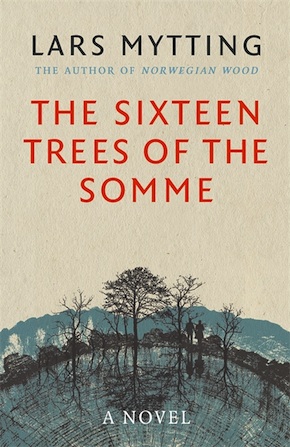The Leica way
by Mika Provata-Carlone
“Probably the most riveting novel of the year.” Aftenposten
In his previous book, Norwegian Wood (MacLehose Press, 2015), Lars Mytting composed an elegy to trees – not only as an elemental form of life, as symbols, and as the other, vital half of the animate cosmos, but also in their immutable relation to man. Norwegian Wood is about the transcendental materiality of timber, logs, planks, kindling, the hyle of forests and trees and its mythical or ordinary transformations in the hands of man. Artefact, building material, creative body, inspirational source, energy provider or civilising medium, or even as the wherewithal of devouring destruction, wood becomes in Mytting’s narrative evocative of stark simplicity and mesmeric complexity, the very stuff our lives are made of.
In The Sixteen Trees of the Somme Mytting returns to trees and wood, this time as the critical pivot of an eggshell-thin narrative of life that alone can keep the characters from hurtling themselves into a gaping abyss. Here the living plant and the appropriated man-made object possess a binary omnipotence, a minimalism dynamically interlaced with multifaceted intricacy; they are the pragmatic evidence of presence and substance, indivisible from infinite layers of pastness and gossamer-thin veils of presentness and futurity.
The Sixteen Trees of the Somme tells a story of isolation and of the quest for community, a tale of fear and of the yearning for release; it is a narrative of reflection, of memory failing, memory lost and memory regained. It possesses darkness, the gleaming flickering of light and the promise of salutatory insight. A boy grows in a fecund solitude that contains the sinister and the miraculous in almost equal measure, in a 20th-century Heidi-like household that includes a darkly enigmatic, recluse grandfather and a farm, where life and death have always alternated in the midst of a natural landscape that is as dramatically beautiful as it is pregnant with tragedy. Screaming silence and healing Nordic stillness form the background, the frame of vision and of analysis of single and multiple pasts, dreams and nightmares, singular and unexceptional lives. A camera, an M6 Leica with a full set of macro, telescopic, panoramic and fish-eye lenses, becomes the catalyst for tensions suffused with chilling mystery, tangential coherence, unsettling gaps in the continuum of life and understanding, which threaten the very possibility of existence. A legendary manual, The Leica Way in its English edition, will become language and metaphor, image-maker and the developing solution of stills lost in the furrows of remembrance. The art of framing, contrast, composition, exposure and filtering, of pictorialising what the eye sees into what the conscience desires, will become the skill of decoding reality and illusion, of signification, of finding meaning in a maelstrom of experience and guilt-ridden innocence.
Mytting writes with the unembellished exactness of coarse-grain film and the poetry of lost intuitions and possibilities.”
Mytting contrasts the epic terror of WWI with the heinous Nazi atrocities of WWII, lethal green poison gas mines and the Black Watch pitted against the Green Mina death trucks of Ravensbrück and the black SS uniforms; it brings into a sharp clash two moral and historical choices, multiple horrific traumas and lacunae as well as frail or dissembling personal stories; it places on the scale of the Absolute the possibility of a life free from memorialisation and empowered by memory, even when the gesture of recollection is an act of intense pain, an event of irreparable loss. “Death is not always a cruel, unseeing killer. Sometimes it leaves the door open on the way out… But being set free can be sheer torture” we are told early on by a modern-era Peer Gynt, who will possess a greater alertness, a subtler self-awareness, as he tries to be author and text at the same time. Mytting writes with the unembellished exactness of coarse-grain film and the poetry of lost intuitions and possibilities, he combines the rhetoric of an earlier feel for language and literature with the need for images and words that will sustain the continuity with a more contemporary reality. He is the artist, the writer-photographer who captures and interprets the past, the present moment and infinity: the intimation that “we are many who talk about heaven. But few who understand eternity” becomes the underlying drive behind the characters’ choices, in an attribution of meaning that oscillates audaciously between the absolute and the merely human.
 A key question is that of the ownership and stewardship of history and stories. Is a family’s past the legacy and exclusive possession of each generation who are its arbiters and gatekeepers, or is it a thing of transcendental power? Is the fantasy of being someone else, beyond who we are, possible or even desirable? The original title translates as Swim with those who drown, and its Ibsenian undertones are resonant throughout: “Some people survive best by nailing together some kind of truth. Even if it’s crooked or full of cracks, it might still hold. For many people, it blocks out life.” Loss, despair, delusion are also among the phantoms the characters must confront, until they can say “I made a deal with my grief. I would be someone the dead could rely on.” Trees invest places, people, the shadows of the real with redoubtable symbolic power. They are the concrete that anchors a perception at risk of hallucination; they are a palliative state of being without consciousness, as well as the unconscious life bubbling to the surface. They are the primordial substance of creation, a symbol of the process of life at its most vital and basic: germination, growth, death, afterlife. They illustrate the continuity of generations, and mediate between the inanimate and the human spirit and will, they resolve the conflict between individuality and multiplicity: many roots merging into a single trunk that devolves into many branches. The rings and patterns of timber hold secrets and reveal beauty, natural or man-made, a recurrent theme in Mytting’s writing: unless we can be moved by it, we cannot be alive. Trees hold the key to an absolute reality just as they evince the necessity for tangible human simplicity – a child’s handmade wooden toy holds as much metaphysical truth as a shattered altarpiece invisibly repaired by a master craftsman seeking redemption.
A key question is that of the ownership and stewardship of history and stories. Is a family’s past the legacy and exclusive possession of each generation who are its arbiters and gatekeepers, or is it a thing of transcendental power? Is the fantasy of being someone else, beyond who we are, possible or even desirable? The original title translates as Swim with those who drown, and its Ibsenian undertones are resonant throughout: “Some people survive best by nailing together some kind of truth. Even if it’s crooked or full of cracks, it might still hold. For many people, it blocks out life.” Loss, despair, delusion are also among the phantoms the characters must confront, until they can say “I made a deal with my grief. I would be someone the dead could rely on.” Trees invest places, people, the shadows of the real with redoubtable symbolic power. They are the concrete that anchors a perception at risk of hallucination; they are a palliative state of being without consciousness, as well as the unconscious life bubbling to the surface. They are the primordial substance of creation, a symbol of the process of life at its most vital and basic: germination, growth, death, afterlife. They illustrate the continuity of generations, and mediate between the inanimate and the human spirit and will, they resolve the conflict between individuality and multiplicity: many roots merging into a single trunk that devolves into many branches. The rings and patterns of timber hold secrets and reveal beauty, natural or man-made, a recurrent theme in Mytting’s writing: unless we can be moved by it, we cannot be alive. Trees hold the key to an absolute reality just as they evince the necessity for tangible human simplicity – a child’s handmade wooden toy holds as much metaphysical truth as a shattered altarpiece invisibly repaired by a master craftsman seeking redemption.
Places too hold the power to save or to damn: the Norwegian farm is a refuge, a reality test but also a place of impossibility and bareness until a journey and a rite of passage have been completed; the Shetlands emerge as a place between lore and history, present and timelessness, where things cost what your pung or lommebok can afford; “the Somme releases the loss in people; [it] creates a longing for meaning and life, for something humane.” Objects fix the historicity of people and their world, as well as their sense of identity and belonging: from the princely Leica outfit to the era- and class-specific Pioneer stereo, to the iconic black Mercedes and Riva boat, the Cordings tweeds, John Lobb derbys and Truefitt & Hill cologne, to the Balkan Sobranie and the Turnbull & Asser shirts, the material galaxy of the characters’ existence codes and deciphers them, gives them stereotype personas as well as faces, yet without setting them to stone – like trees and wood, they continue to breathe, mature, change forms and reveal new hues, textures, depths of being.
Felling a tree or nurturing a wood, taking or leaving the Leica behind become the vocabulary of a ‘this side of language’ that will finally weave together the severed strands of many lives.”
The Sixteen Trees of the Somme conceals genuineness and purity of diction behind a story that intertwines the historical experience with the mysterious, the thrilling, the if-only fairy-tale romance, the whole spun together with a mythographer’s skill for creating symbols out of allegories, lore out of facts, experience out of events, wisdom out of fault and failure. Felling a tree or nurturing a wood, taking or leaving the Leica behind, opting between wellies and bespoke footwear, choosing the flawless fit of habit or the friction of a more potent union become the vocabulary of a ‘this side of language’ that will finally weave together the severed strands of many lives, many episodes of history, into an anonymous vita beata. Reading the log of visitors at the Commonwealth War Graves Commission, the narrator Edvard Hirifjell “read how the pattern of grief changed as parents grew older or passed away; how the legacy of war which began as a bloody family tragedy turned into a historical, national event.” In his turn, he will transform an abortive historical legacy and the memory of personal and adjunct surrogate guilt into a possible life. Fluidly translated, Mytting’s book is as much a romantic historical thriller as it is a book of promise, a page-turner as it is a reflective journey into selfhood, history, life’s meaning and individual moral responsibility – and one certainly looks forward to his next literary venture.
 Lars Mytting is a novelist and journalist born in Fåvang in Norway’s Oppland county in 1968. Svøm med dem som drukner (The Sixteen Trees of the Somme) was awarded the Norwegian National Booksellers’ Award and has been bought for film. Norwegian Wood has become an international bestseller, and was the Bookseller Industry Awards Non-Fiction Book of the Year 2016. The Sixteen Trees of the Somme, translated by Paul Russell Garrett, is published by MacLehose Press in hardback and eBook.
Lars Mytting is a novelist and journalist born in Fåvang in Norway’s Oppland county in 1968. Svøm med dem som drukner (The Sixteen Trees of the Somme) was awarded the Norwegian National Booksellers’ Award and has been bought for film. Norwegian Wood has become an international bestseller, and was the Bookseller Industry Awards Non-Fiction Book of the Year 2016. The Sixteen Trees of the Somme, translated by Paul Russell Garrett, is published by MacLehose Press in hardback and eBook.
Read more
larsmytting.net
Author portrait © Julie Pike
Paul Russell Garrett is a translator from Norwegian and Danish based in London. His recent translations include Lars-Henrik Olsen’s Erik and the Gods and Alen Meškovic’s Ukulele Jam.
paulrussellgarrett.com
@MrPaulGarrett
Mika Provata-Carlone is an independent scholar, translator, editor and illustrator, and a contributing editor to Bookanista. She has a doctorate from Princeton University and lives and works in London.

